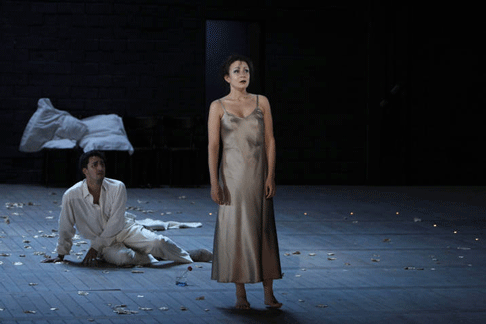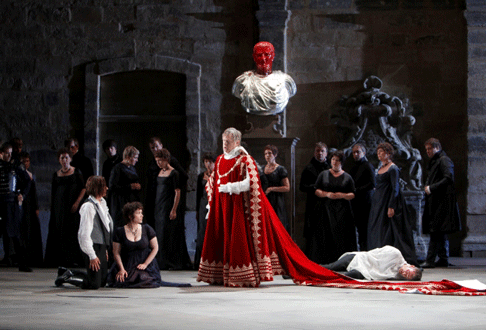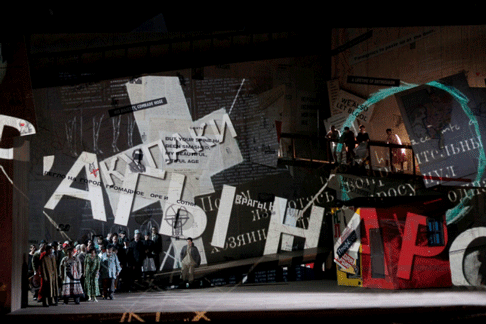Natalie Dessay is more or less a national hero here in France, maybe even more famous than Carla Bruni. Nonetheless there are those of us who are not fans of Mme. Dessay, thus we were relieved to be able to attend one of the four performances of La traviata sung by Irina Lungu.
Ironically the star of this traviata finally was not Mlle. Lungu nor probably was it la Dessay but its metteur en scene Jean-FranÁois Sivadier, an actor and later playwright who declared his love for la traviata back in 1996 in a theater piece that became very famous in France. Called Italienne avec orchestra, it was based on fictional rehearsals for a presumed production of La traviata.
Mr. Sivadier has truly fulfilled his dreams these many years later, and given enormous pleasure to Aix audiences with his finally finished traviata. For Mr. Sivadier Violetta is not a courtesan but an actress, a calling far more familiar to most of us these days. Though a concession to current perceptions is not Mr. Sivandier’s intention (he offers a convoluted rationale in his program booklet apology) it was an interpretive tool that accommodates a diva as an actress, not troubling her to attempt a character, here Piave’s sympathetic courtesan.
The hard part was not seeing Mme. Dessay, for whom Mr. Sivandier’s production was finally created, in every move and gesture made by young Russian soprano Irina lungu, an ingenue traviata. Once past this distraction however Mlle. Lungu made this Violetta her own, her fresh voice, burnished tone and fine Italianate style well sustaining the substantially different vocal demands of the first and last acts, her almost convincing diva stage presence unencumbered by a famous name and excessive fame.
Mr. Sivandier’s traviata catalogued virtually every twentieth theatrical clichÈ, from Brechtian devices to physical theater, from Stanislavski acting to cinematic realism, and of course plenty of scenic graffiti. Since his basic metaphor was self-conscious theater the use of such diverse techniques was central to his concept, and amusingly appropriate.
The traviata herself was the most theatrically abstracted character, dying without so much as a cough, simply walking forward into bright light with the blackout just at the moment she would step into the pit. Alfredo was the least abstracted character, the admirations, supplications and sufferings of a most sympathetic Charles Castronovo were cinematically real, and very human. This young American tenor is a light voiced, stylishly correct singer. He sang all ten performances, some back to back, perhaps explaining the cracked b-flat as he stormed off-stage to follow Violetta to Paris (7/18).
Germont fulfilled the psychological reversals (reinterpretations) that fulfill later twentieth century theatrical exigencies. No longer the gentle, hurt father French baritone Ludovic TÈzier realized a bullying Germont with steely tone and threatening, uncomfortable presence. And yes, the ‘Di Provenza’ cabaletta was restored, dramatically motivated by a cowering Alfredo. Mr. Castronovo is a fine actor.
 Irina Lungu as Violetta and Charles Castronovo as Alfredo
Irina Lungu as Violetta and Charles Castronovo as Alfredo
This Aix traviata was made festival fare by availing itself of unusual operatic collaborators. Veteran opera conductor Louis LangrÈe conjured a traviata of extraordinary sweetness and passivity taking advantage of the symphonic resources of the London Symphony Orchestra, indulging in beauty of symphonic tone rather than dramatic pressures. The Estonian Chamber Choir provided pleasurable, excessively careful tone and musicianship in its stolid presence, betrayed by the two female choristers who executed fine physical theater, full body death collapses in their fourth act rejoicing, a vista in Mr. Sivadier’s rehearsal production.
The action of Mr. Sivadier’s opera took place on an empty stage during Traviata rehearsals — a constructed empty stage erected on the stage of the ArchevechÈ theater. The back wall was black, simulated brick. There were minimal costumes (Annina was Violetta’s wardrobe assistant) — Violetta’s rehearsal costume was a leftover sort of commedia dell’arte Colombina). There were few hand props — flower bouquets presented to the diva by admirers, and champagne glasses. A few small painted cloud flats and de rigueur crystal chandeliers flew in from time to time to suggest locale.
 Scene from La clemenza di Tito
Scene from La clemenza di Tito
The Aix Festival’s La clemenza di Tito occurred within the actual empty stage housing of the ArchevechÈ Theater, the back wall of which is the south courtyard facade of this old bishops palace. This last of the Mozart operas was staged by David McVicor, a member of good standing of the British opera director cabal. Perhaps this accordance to British artistic imperialism was determined by the presence of the London Symphony Orchestra succeeding the Berlin Philharmonic as the festival’s orchestra in residence.
The LSO was again in the pit, with none other than Sir Colin Davis at the helm, though at this point he is more a reverential presence than a musically inspirational one. But we enjoyed rock solid Anglo-Saxon sound, musicianship and style. All this added little to the performance (7/06) as this strange, anachronistic opera seria demands a determined pit presence, here sorely lacking.
The Aix Festival at its best profits from intelligent artistic gullibility, but it was obviously tricked into acceding to stage director Mr. McVicor the creation of the scenic space for his staging of Tito. This amounted to a clumsy, huge gray stair unit (some sort of temple) stage left, and a couple of black columns sitting on a small black platform stage right. Both units rolled on and off stage from time to time, though a monumental white marble statue of Tito remained on the stage all the time. Its face turned red when Sextus was to be executed at Titus’ command.
Yes, you got it — shades of black, white and red (for blood). Red lighted theatrical fog (i.e. smoke) oozed through the apertures of the faÁade of the bishop’s palace during the Roman uprising. All this Mr. Vicor’s idea of minimalism.
Tito was costumed in a white satin 18th century formal court dress quotation that included a powdered wig and shiny white shoes. He dragged a twenty-foot mantel that he tried to fold up when governing became all to much for him, and comically it was a bit much for him to organize Mr. Vicar’s conceit. But Tito finally forgave everyone, almost. Mr. McVicor had a surprise up his sleeve — Tito’s eight black costumed, semi-balletic dragoon figurants (extras) skewered Vitelia (a solid black gown)! Blackout!
American tenor Gregory Kunde took the place at the last minute for an indisposed John Mark Ainsley as Tito. Mr. Kunde has enjoyed much success at the Rossini Festival in Pesaro over the years. He is not a Mozart singer or an elegant performer. Italian soprano Carmen Ginnattasio as the antagonist Vitelia offered mannered, spat Italian with grating “r”’s — fun for a while. English soprano Sarah Connolly brought solid Anglo-Saxon artistry to Sextus, but nothing more.
Win some, lose some.
 Scene from Le Nez/The Nose
Scene from Le Nez/The Nose
The third and last big production of this sixty-third Aix festival was Shostakovich’s Le Nez/The Nose (ticket price $340), a co-production with New York’s Metropolitan Opera where it opened last year (ticket price $240 +/-), and the OpÈra de Lyon where it plays in October (ticket price $140).
South African artist/actor William Kentridge is the author of this production, thus instead of the filter of a symphony orchestra between the opera and its production (as for the Traviata and Tito) there was the filter of a mature, powerful contemporary visual artist to distance us from this youthful (composed by Shostakovich when he was 22 years old) experiment/prank/masterpiece.
Casting was as problematic as it had been in New York. South Pacific star Paulo Szot, the Met’s Kovaliov (who loses his nose), had been replaced by Albert Schagidullin who was replaced after the program was printed by Vladimir Samsonov. Though a veteran of the role at Paris’ Bastille Mr. Samsonov who began his career as an operetta artist was not a big enough singer or strong enough performer to command the stage in Aix.
In his previous opera productions (Il ritorno d’Ulisse and Die Zauberflˆte) Mr. Kentridge has used puppetry to great effect. This theatrical abstraction is echoed in his visual art in abstracted black two-dimensional human forms on white background and sometimes some red lines as well, and here these paper cut-out forms sometimes re-appeared in marching formation during musical interludes.
Mr. Kentridge offered many collages as well including a show curtain that was an abstracted newspaper with both English and now French catchy news items teasing early socialism. To distance or distract us further from Gogol’s derisive text other interlude collages included such video images as a middle-aged Shostakovich playing the piano!
Mr. Kentridge’s visual language is essentially good natured, with studied charm. He projected this temperament onto the staged scenes by making Sweeney Todd like vignette’s pop out of the show curtain from time to time. This technically complex, completely finished production teetered on the edge of popular musical theater. Maybe this is why the public in the 1350 seat, indoor Grand ThÈ‚tre de Provence roared its approval (7/08), and the word on the street was that it was a great show!
The strengths of the production were the resources of the OpÈra de Lyon, its music director Kazushi Ono providing a chiseled if somewhat restrained reading of this extravagant score by the fine orchestra of what is certainly France’s premier opera company. The contributions of the chorus of the OpÈra de Lyon gave real pleasure as well.
To these strengths add the fine, appropriately expressionistic, exaggerated characters of Gogol’s ravings enacted by tenor Andrei Popov as the Inspector, Vladimer Ognovenko as the Barber and Vasily Efimov as Kovaliov’s servant (all veterans of the Met cast). The casting of Tehmine Yeghiazaryan as the Daughter of Madame Podtotchine is however inexplicable (after all you paid $340 for your ticket!).
Coupling Mr. Kentridge’s puppetry with Mozart’s puppet opera masterpiece, The Magic Flute made sense. His production was enthralling. In Aix just now however the strident young Shostakovich was shortchanged. It was a long one hour forty minutes.
Michael Milenski
image=http://www.operatoday.com/Traviata_Aix.gif
image_description=Natalie Dessay as Violetta [Photo by Pascal Victor / Artcom Art courtesy of Festival d’Aix en Provence]
product=yes
product_title=Giuseppe Verdi: La traviata; W.A. Mozart: La clemenza di Tito; Dmitri Shostakovich: Le Nez/The Nose
product_by=Click here for La traviata production information
Click here for La clemenza di Tito production information
Click here for Le Nez/The Nose production information
product_id=Above: Natalie Dessay as Violetta
Photos by Pascal Victor / Artcom Art courtesy of Festival d’Aix en Provence